The shop assistant turned World War Two Land Army girl Alison Smith, clad in a summer dress on the sabbath, steps through a glade onto a hilltop track above the village of Chillingbourne in Kent. It’s the same road once taken by medieval pilgrims riding to seek blessings or do penance at Thomas Becket’s shrine in Canterbury Cathedral.
The cathedral tower can be seen seven or eight miles away. Though no other human or beast is in sight, Alison (Sheila Sim, pictured below) looks up in a wondering full-face closeup, for she can hear the clop of hooves, the jingle of harness bells, and lutesong, long bygone sounds borne to her on the breeze tousling her hair.
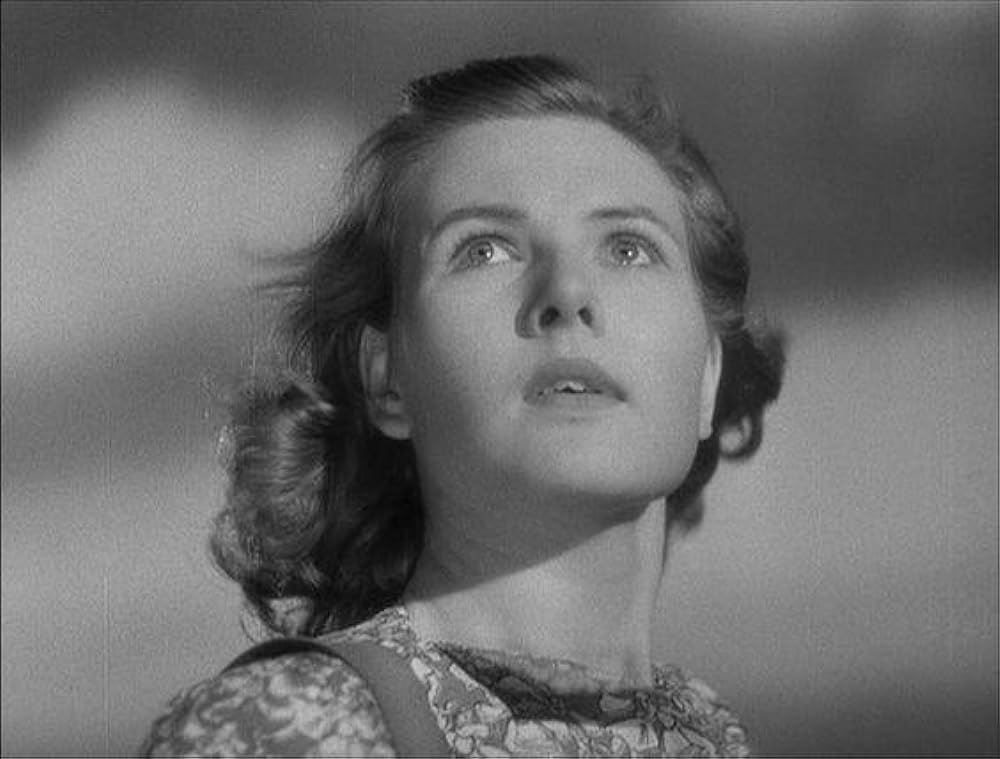 The village squire Thomas Colpeper, JP (Eric Portman) told Alison and the soldiers attending his lantern slide lecture on the Pilgrims' Way the evening before that they could expect such a reverie. Now here is Colpeper popping up in the tall grass 10 yards from Alison and explaining that the sounds “come from inside”. This makes them no less spectral.
The village squire Thomas Colpeper, JP (Eric Portman) told Alison and the soldiers attending his lantern slide lecture on the Pilgrims' Way the evening before that they could expect such a reverie. Now here is Colpeper popping up in the tall grass 10 yards from Alison and explaining that the sounds “come from inside”. This makes them no less spectral.
Unseen forces are at work in A Canterbury Tale (1944), the first of the two pastoral allegories with which the Archers writer-director-producer team of Michael Powell, a man of Kent, and Emeric Pressburger, a Hungarian émigré, sought to define the spiritual values Britain was fighting for during the war and believed would sustain it in peacetime.
Except for conventional ghost stories, such as Dead of Night (1945), Scrooge (1951), and The Innocents (1960), and Hammer’s Gothic tales, British film was wary of the supernatural until the 1960s and 1970s folk horror wave opened the doors to the likes of Don’t Look Now (1973) and The Company of Wolves (1984).
Powell and Pressburger were pursuing something different – a mystical pantheism presaged by the Shakespeare who wrote “one touch of nature makes the whole world kin” and sent his own “pilgrims” into the essentially English enchanted realms of Arden in As You Like It, the wood in A Midsummer Night’s Dream, and The Tempest’s island. Neither before or since A Canterbury Tale and the like-minded I Know Where I’m Going! (1945) has the numinous been rendered with such beneficence and visual lyricism, though Bill Forsyth’s Local Hero (1983) and Comfort and Joy (1984) are touched with kindred magic.
 A Canterbury Tale starts with Esmond Knight (who also plays a soldier and Chillingbourne’s village idiot) narrating the opening words of the prologue to The Canterbury Tales as Chaucer’s pilgrims climb a bank to the dusty Kentish track en route to the cathedral city, “The hooly blisful martir for to seke/That hem hath holpen whan that they were seeke”.
A Canterbury Tale starts with Esmond Knight (who also plays a soldier and Chillingbourne’s village idiot) narrating the opening words of the prologue to The Canterbury Tales as Chaucer’s pilgrims climb a bank to the dusty Kentish track en route to the cathedral city, “The hooly blisful martir for to seke/That hem hath holpen whan that they were seeke”.
Twenty four years before Stanley Kubrick telescoped millennia of technological progress with 2001: A Space Odyssey’s match cut showing a primate’s tossed bone evolving into a drifting satellite, Powell and Pressburger bridged a mere 600 years by turning a soaring falcon released by Chaucer’s Squire (pictured above) into a swooping Spitfire. The Squire in his medieval garb is transformed into a British infantryman (extra James Sadler in both cases).
It’s now the summer of 1943. Total war has come to the home counties and night has fallen on Chillingbourne station. Alison, the American sergeant Bob Johnson (John Sweet), and the British sergeant Peter Gibbs (Dennis Price) alight from the day’s last train to Canterbury. Alison is to work on Colpeper’s farm and Peter is to join his unit on manoeuvres near the Chillingbourne army camp, but Bob disembarks mistakenly thinking he’s already reached Canterbury, where he’s to meet a buddy.
When Bob refers to Chillingbourne as a whistlestop, the stationmaster Thomas Duckett (Charles Hawtrey) gives him some waspy attitude as he explains the village was constituted a municipal borough “407 years before Columbus discovered America”. It’s not the last English history lesson Bob will be taught.
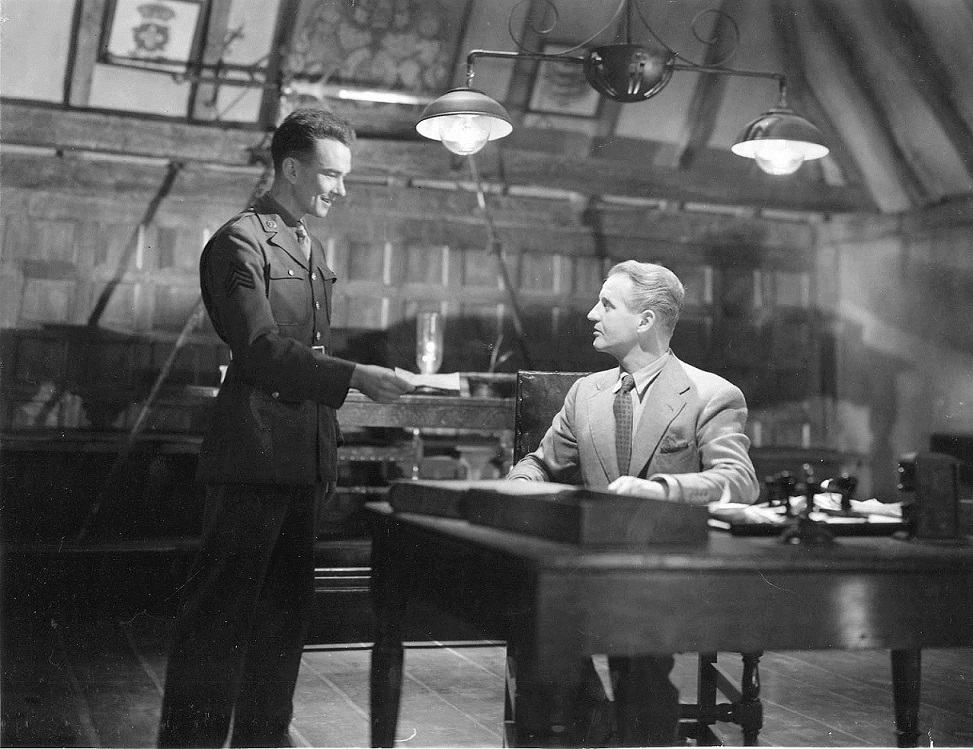 As Alison, Bob, and Peter walk into the village in the blackout, a uniformed man dashes from the shadows, pours glue on Alison’s hair in a scuffle, and flees before his face is seen. In the next few days, the three investigate the incident, the eleventh such assault on young women in Chillingbourne.
As Alison, Bob, and Peter walk into the village in the blackout, a uniformed man dashes from the shadows, pours glue on Alison’s hair in a scuffle, and flees before his face is seen. In the next few days, the three investigate the incident, the eleventh such assault on young women in Chillingbourne.
In the sequence that introduces the supercilious Colpeper in his office in the town hall, where as the local magistrate he must interview Bob and Alison and log their names as wartime arrivals in the village, two bits of evidence reveal to the audience that he’s “the glueman”. (Only later does the trio establish his guilt through some Chestertonian detective work involving Colpeper’s Home Guard duty schedule.) A Canterbury Tale is not a whodunit, therefore, but a whydunit. (Pictured above: John Sweet, Eric Portman)
The investigation is the Archers’ ruse to lull Alison, Bob, and Peter – the audience, too, via a flow of lambent and expressionistic images photographed by Erwin Hillier and orchestrated almost hypnotically by gentle cuts and dissolves – to Chillingbourne’s timeless rhythms. The captains of two friendly armies of village boys enjoying an idyllic war, their staged battle witnessed by Bob, play their part in identifying the glueman. To their surprise, the three modern pilgrims are soothed and rejuvenated by their acclimation to the village, where Alison will remain after Bob and Peter are mobilised.
I Know Where I’m Going!’s Joan Webster (Wendy Hiller) also succumbs to “the spirit of place”, one unpredictably bossed by Celtic faerie. Businesslike Joan travels from Manchester to Scotland, determined to marry a much older rich industrialist spending his war on the (fictitious) island of Kiloran in the Hebrides.
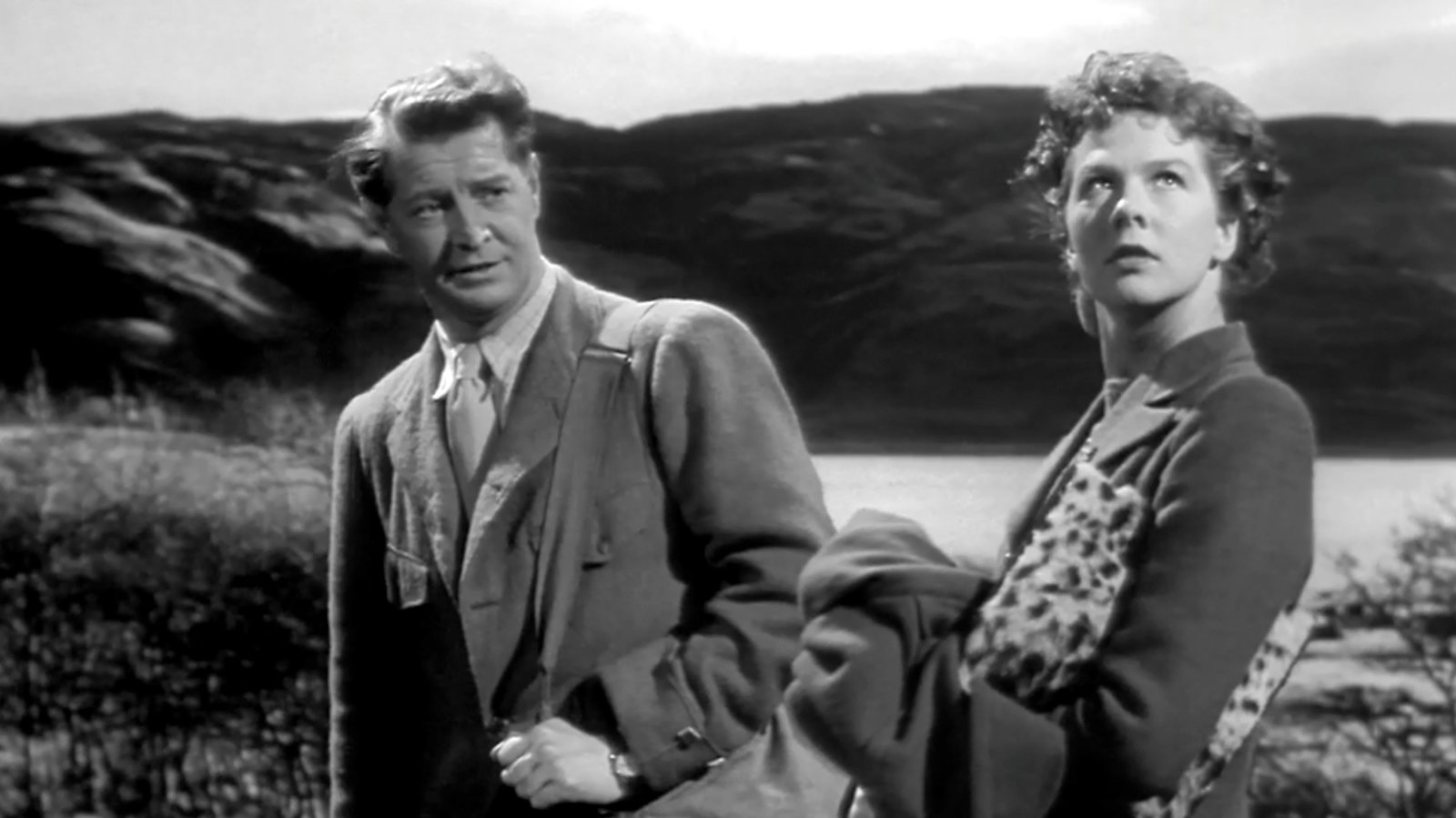 She finds herself stranded by a non-navigable storm on Mull in company with Kiloran’s impoverished but irritatingly attentive and passionate laird, Torquil MacNeil (Roger Livesey, pictured left with Wendy Hiller). The warmth and vigor of the locals – and, of course, her dawning feelings for Torquil – disabuse Joan of her utilitarian worldview. She, in turn, impels Torquil to confront an ancient curse placed on his clan.
She finds herself stranded by a non-navigable storm on Mull in company with Kiloran’s impoverished but irritatingly attentive and passionate laird, Torquil MacNeil (Roger Livesey, pictured left with Wendy Hiller). The warmth and vigor of the locals – and, of course, her dawning feelings for Torquil – disabuse Joan of her utilitarian worldview. She, in turn, impels Torquil to confront an ancient curse placed on his clan.
With its rustic architectural and decorative antiquities, Chillingbourne is a repository of post-1066 lore and customs, though Alison knows the Normans were only the last invaders. Three years before, she and her geologist fiancé Geoffrey holidayed nearby, staying in a caravan on “the Bend” on the Pilgrim’s Way, where he found a caché of Roman coins in a dig.
LIke This England (1941), Went the Day Well? (1942), The Demi-Paradise (1943), Tawny Pipit (1944), A Captive Heart (1946), and Hollywood’s Mrs Miniver (1942), A Canterbury Tale is propaganda, as author Andrew Moor notes in Powell & Pressburger Cinema of Magic Spaces (2005), for the Victorian myth-cult of idealised and predominantly Southern rural village life that emerged from Romanticism’s stand against the dehumanising, polluting, and uglifying aspects of the Industrial Revolution.
Consistent with the Archers’ so-called High Toryism, A Canterbury Tale’s ardent preservationism – dedicated to “the old ways”, whether routes or yeomen’s methods of work – feeds the film’s utopian Arcadian fantasy. It is nowhere stronger than in the Chillingbourne forge where Bob, a country boy raised in the Oregonian lumber business, strikes up a friendship with the blacksmith Jim Horton (Edward Rigby, pictured below with John Sweet) as they discuss the right months for seasoning elm, oak, and beech.
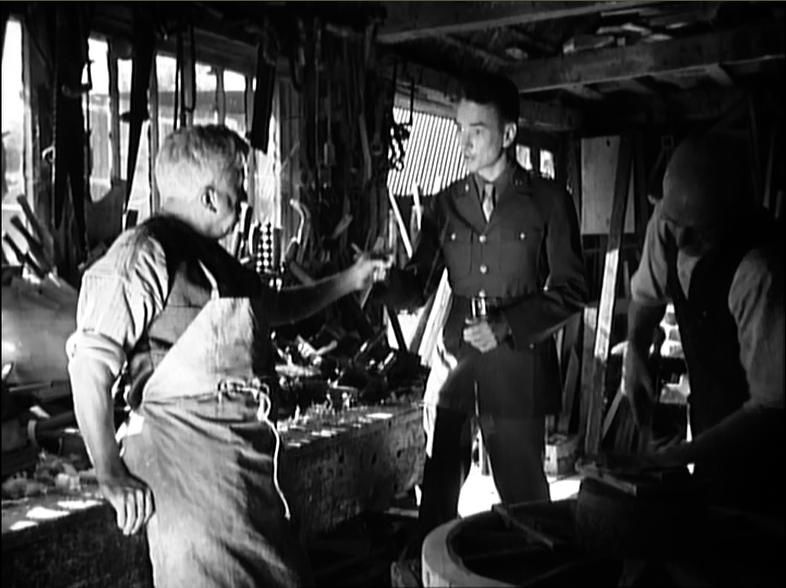 Redolent of Victorian genre paintings, the scene was intended to resonate with those urban moviegoers, prone to nostalgia, who visited the countryside rarely but waxed nostalgic about cricket on the village green and sent Christmas cards depicting horse-drawn coaches ploughing through snowy fields to Dickensian inns.
Redolent of Victorian genre paintings, the scene was intended to resonate with those urban moviegoers, prone to nostalgia, who visited the countryside rarely but waxed nostalgic about cricket on the village green and sent Christmas cards depicting horse-drawn coaches ploughing through snowy fields to Dickensian inns.
The recognition that American and Britain were fighting to preserve the same values, implicit in Bob and Jim’s affinity, is echoed when Bob, later awed by Canterbury Cathedral’s Perpendicular nave, marvels out loud to himself, “And my dad’s pa built the first Baptist church in Johnson County. Oregon red cedar, cedar shingles, 1887. Well, that was a good job, too.”
But Alison, Bob, and Peter are all suffering a soul sickness, hence their need for blessings at the martyr’s shrine. Alison is grieving for Geoffrey, who joined the RAF and has been lost to “enemy action”. Bob’s girlfriend back in Oregon has stopped replying to his letters. The classically trained organist Peter has ended up playing cinema Wurlitzers.
Each has also felt the pull of capitalist-driven materialism. Alison loves the countryside but has ended up selling gardening furniture and picnic baskets in a London store. A nature lover who is curious about English culture, Bob nonetheless spends his army leave at the movies rather than exploring. Bob, an organist who studied at the Royal Academy of Music, plays “cards with the boys’ and goes to pubs in his spare time. Having learned of these failures of imagination in separate conversations with each of them, Colpeper (pictured below) becomes their agent of enlightenment.
 An antiquarian and modem missionary zealously dedicated to teaching people about the spiritual past of his corner of East Kent, and how they might retrieve it by surrendering to the Wordsworthian atmosphere of the places where it unfolded, he is not only a genius loci but the instrument of the miracles that befall Alison, Bob, and Peter.
An antiquarian and modem missionary zealously dedicated to teaching people about the spiritual past of his corner of East Kent, and how they might retrieve it by surrendering to the Wordsworthian atmosphere of the places where it unfolded, he is not only a genius loci but the instrument of the miracles that befall Alison, Bob, and Peter.
After Colpeper learns they have deduced he is the glueman, Bob moves to report him to the Canterbury police but is diverted into the cathedral. There he’s permitted to fulfil the musical vocation he’d cynically relinquished by playing Bach’s “Toccata and Fugue in D Minor” and “Onward Christian Soldiers” on the organ for the battalions (including his own) leaving for overseas. Not far from the cathedral, dreams also come true for Alison and Bob.
Peter’s occurs after he picks up and returns to its owner a sheet of music that wafted down the steps to the organ loft having been dropped by the tart-tongued organist (Eliot Makeham), who warms to the younger man after he learns of his academic training. In I Know Where I'm Going!, a reverse mystical intervention – whether divine or pagan – blows from Joan’s hands into the sea the unromantic travel and pre-wedding itinerary she has been given by one of her fiancé’s humourless minions.
Film scholars have tended to focus on A Canterbury Tale's spiritual message, woven as it is with cultural and political agendas, rather than on the love woes that the Archers used to freight the anti-materialist theme to the wartime audience. Yet Alison’s pain is made especially affecting by Sheila Sim. Bob's plight would have been felt keenly by servicemen who'd been abruptly separated from their girlfriends and wives and feared losing them, as Colpeper has sympathetically intuited.
 The self-evident Freudian aspect of Colpeper pouring what Alison calls “sticky stuff” on her and the other girls’ hair has precluded much discussion of his psychological motives. Powell admitted that he often decided to go with Pressburger’s stories and themes even when he didn’t fully understand them.
The self-evident Freudian aspect of Colpeper pouring what Alison calls “sticky stuff” on her and the other girls’ hair has precluded much discussion of his psychological motives. Powell admitted that he often decided to go with Pressburger’s stories and themes even when he didn’t fully understand them.
“Emeric thought up the glueman,” he told me in a 1986 interview. “We had some rather important things we wanted to say in A Canterbury Tale, so when he proposed this almost sexual idea of a man pursuing girls in the blackout and dropping glue on them, I thought. ‘Oh Christ, this is going to stop the staid British in their tracks. I’d better not tell Emeric because he might abandon the idea.’ (Pictured above: Eric Portman and Sheila Sim)
“To try to put over these very serious ideas about England and America and the values we were fighting for might have turned the film into a self-praising documentary, so instead of that I let the glueman ride,” Powell continued. “I said to myself, ‘I think I can get away with it,’ but I couldn’t.”
The glueman’s terrorism, Colpeper says, speaking of himself in the third person when Alison, Bob, and Peter cross-examine him on the Monday morning train to Canterbury, was intended to stop Chillingbourne’s women from going out with locally camped soldiers while their husbands and boyfriends were away at war. He thus rationalised his hope that – with nothing to do until the pubs opened – the soldiers would attend his lectures about the Pilgrims' Way.
Copper’s glue-pouring has been construed as a baptismal act prompted by his urge to “pour knowledge” into his victims’ heads, an argument that falls down because, until Alison attended his Saturday lectures, no women had been invited to them. When she asks him if thought to ask them, he bluntly answers no.
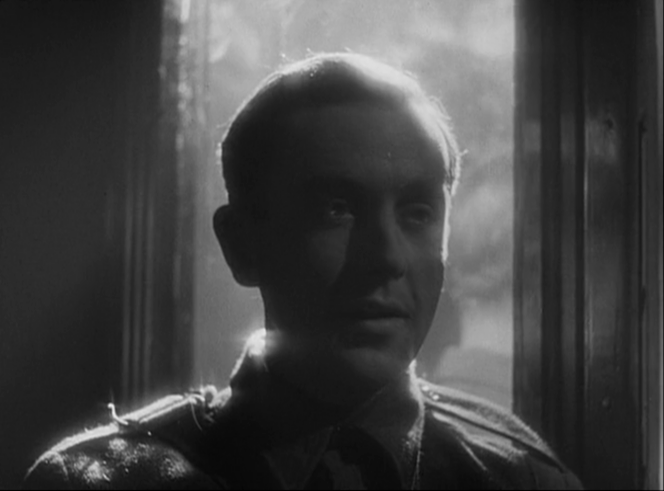 This self-appointed demi-urge might be a crank with a well-meaning vision, but he is also a man, one of the most conflicted in Powell and Pressburger’s canon, who, like Alison, Bob, and Peter, requires redirecting.
This self-appointed demi-urge might be a crank with a well-meaning vision, but he is also a man, one of the most conflicted in Powell and Pressburger’s canon, who, like Alison, Bob, and Peter, requires redirecting.
When at their first meeting Bob asks Colpeper about a ducking stool attached to a beam in his office, the squire admits to a misogynistic streak by saying he approves of its medieval use on talkative women.
That Colpeper is a bachelor in his mid forties who lives with his formidable mother (Margaret Scudamore) invites speculation about his sexuality. Not to mitigate the abusive nature of his attacks, that they (mercifully) don’t involve genital contact indicates the depth of his repression. (Pictured above: Dennis Price as Peter, haloed on the Canterbury train)
But watch Colpeper’s interactions with Alison. When he sees her – the latest “incident”, hair newly washed – climb the stairs to his office and her face comes into the light, he steps toward her, as if magnetised by her loveliness. His disdain reasserts itself immediately when Alison tells him she’s been sent by the Agricultural Committee to work on his farm. He refuses to employ her, saying he needs a farm labourer, despite Alison’s aptitude for work done by men in peacetime. “Miss Smith, there’s a camp near here full of soldiers…aren’t you afraid?" he says. ”Because of what happened to you?”
She isn’t afraid, the soldiers mean nothing to her, but Colpeper is disturbed by the thought of having a robustly healthy and attractive young woman working his land, perhaps because he knows that younger and manlier men than him would try to make love to her. A Canterbury Tale’s mysticism can’t brook earthy needs or Colpeper’s psychosexual anxiety.
Prudence Honeywood (Freda Jackson), an unmarried neighbouring farmer in her mid thirties, tells Alison shortly after she hires her the next morning that the only man who asked her to marry him wanted her to live with him in a typically “sad” London house. She is “still a maid,” she ruefully volunteers. We might conjecture that Colpeper, for whom Prudence is a shadow figure or secret sharer, has also lived celibately, befitting his priestly asceticism and explaining the pent-up sexual frustration behind his glue attacks.
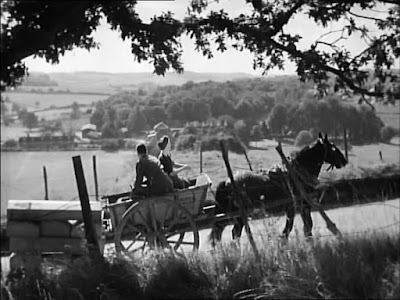 What does Alison think of him? She is still in love with Geoffrey, presumed killed by enemy action, but Colpeper both fascinates and troubles her. When she is driving Pru’s horse and cart, Bob seated in the back, and it passes Colpeper’s house, she starts at the sight of him scything grass in the garden, an image probably inspired by the reaper who eerily tolls a bell beside a Stygian river in Carl Theodor Dreyer’s Vampyre (1932).
What does Alison think of him? She is still in love with Geoffrey, presumed killed by enemy action, but Colpeper both fascinates and troubles her. When she is driving Pru’s horse and cart, Bob seated in the back, and it passes Colpeper’s house, she starts at the sight of him scything grass in the garden, an image probably inspired by the reaper who eerily tolls a bell beside a Stygian river in Carl Theodor Dreyer’s Vampyre (1932).
Colpeper’s appearance here heightens his otherworldiness because it interrupts the leisurely sequence, scored to Allan Gray’s jinking andante tune, that lures the viewer into a trancelike meditation of Chillingbourne’s bucolic beauty. (Pictured above: John Sweet, Sheila Sim, and "Smiler")
Twice more Colpeper materialises beside Alison, like Puck in Kipling’s Puck of Pook Hill, Powell’s favourite book as a child and a key influence on A Canterbury Tale. The first is when he rises up as she walks on the Pilgrims' Way before inviting her to sit with him. Following Alison’s rapt response to Colpeper’s lecture and donation of the Roman coins to his museum, he admits he misjudged her and she him; their values (her empathy for his cause; his admiration for her as an intelligent and capable woman) have merged. Alison's demonstrations that women have the physical strength and resourcefulness to do men's work during wartime, and her insistence on being respected for it, are another theme of A Canterbury Tale that has been neglected.
Lest there be any doubt Colpeper is drawn to Alison, Powell and Hillier changed the camera’s position to make it seem as if the pair's shoulders are pressed together, creating an illusion of romantic intimacy (pictured below: Sheila Sim and Eric Portman). The mood is spoiled when they hear Peter and Bob chatting as they stroll up the hill and mention Alison’s part in their smoking out of “old Gluepeper”.
 In Canterbury, Colpeper shows up suddenly outside the garage where Alison is sorrowfully inspecting her dusty caravan with its moth-eaten curtains. “Everybody has disappointments. Life is full of disappointments,” he says.
In Canterbury, Colpeper shows up suddenly outside the garage where Alison is sorrowfully inspecting her dusty caravan with its moth-eaten curtains. “Everybody has disappointments. Life is full of disappointments,” he says.
Though he seems to be addressing her tragic loss, moments later she receives her blessing. It is a gift from god – evidenced by a slight camera move that frames the cathedral tower in a window panel inside the garage – arranged by Colpeper.
If Colpeper is speaking of his inevitably disappointed feelings for Alison, bearing them must be his penance in lieu of a secular punishment for his glue assaults. Fully redeemed, Colpeper is last seen, his eyes stoically averted downwards as Alison, walking with Geoffrey’s father, passes him standing alone among the people congregating in the cathedral for the service to bless the departing soldiers.
A montage of shots of its great edifice, with one of its pealing bells, ends with a vista of the tower – seen from the Pilgrims' Way and hymned by Allan Gray’s celestial choral refrain. The credits roll over shots of men and women strolling toward one of the ex-glueman’s lectures on an England that, since 1943, has receded so far into myth it is barely recognisable.















Add comment